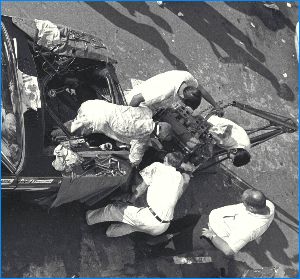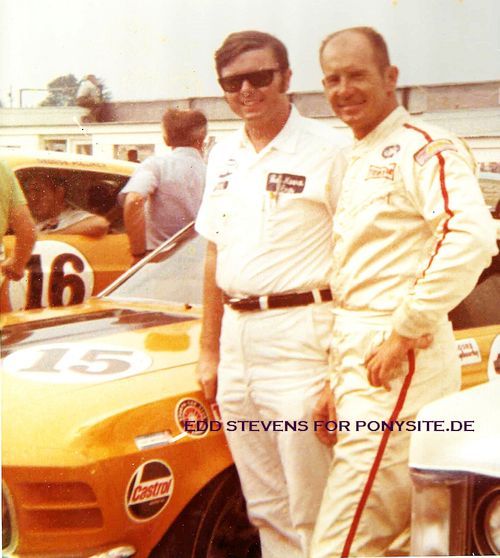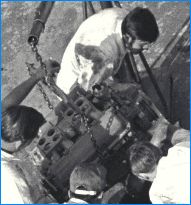
Edd "Double D" Stevens (under the boom of the hoist) and his teammates at St. Jovite 1969. Exchanging an engine on Follmers car. Picture courtesy Ford Media. |
"Hi guys, I worked for Bud during the 1969 and 1970 Trans-Am seasons.
I assembled the engines and did the dyno work. I am pictured in the 1969
St. Jovite Ford photo of the T/A BOSS #16 in front of the car under the
boom of the hoist." |
|
Thanks Edd, for your willingness to give us this interview. Who else was working with you on the engines and what was the influence of Ford on your engine building and tuning? (e.g. from Bill Barr, Denny Wo or others.) |
I worked on the Boss engines plus a couple 289 builds. Denny Wo was very instrumental in the development of the induction system for the 1970 Boss 302. SCCA saw fit to change the rules and eliminate the 2x4 carb setups and go to a 1x4 setup. I remember two other engineers Paul Skiba and Lee Morse that worked on the project. We did dynotesting on exhaust systems, fuel systems and camshafts; I think a lot of it was to verify what Ford had learned. Ford engineers would come down to use the dyno because we could make changes faster than the union workers at Ford. They would help us with any problems we might have and would take the engine that failed and do an analysis of it to solve the problem. For example, in 1970 George blew an engine during the race in Connecticut, the name escapes me. Ford took the engine back to Dearborn to do an analysis. They found particles of glass bead embedded in the rod bearings. They showed us the pictures. They believed that the new race oil pans, they built for us, didn't get all the glass beads cleaned out of them. |
|
Did you exchange datas with Ford (and thus maybe with Shelby)? |
We exchanged data with Ford. It is my personal opinion and observation that Ford was doing all the developmental work, gave us the results and the parts to make it work. Shelby had Ford's ear, but, we had Parnelli and Parnelli wanted Bud to build his cars. Shelby's cars were sleds compared to our cars. I would like to make one thing clear, as far as I know, Bud Moore worked for Ford Motor Company and that we were our own team and Shelby was a different entity. When we were having problems with valve springs in 1969, Shelby had found some that would work and last through a race. He didn't share that information until after St. Jovite! As you know, George blew his engine and collected both of the Shelby cars. After that Shelby's cars were never a real factor. |
|
Do you know anything specific about the contract with Ford - moneywise, e.g. salary, material purchase, general sponsor payments and such? |
I was not privy to the financial part of the deal. However, Ford spent a lot of money to win the Trans-Am Championship! |
|
Which other projects were followed during your time at the shop like boat engines or other projects standing around in the shop? |
We blueprinted a 1969 Mangusta engine for Dave Talekson (sp), who was a SCCA official. We built twin 460 engines for an offshore boat for Bradley Dennis, who was the Autolite NASCAR Rep. We sold a crank and pistons to a World of Outlaw racer that Ford sponsored. We didn't realize that we had to sell them the rods too. It seems that the pistons ended up about a ¼ inch in the hole. They had a problem with the oil cooling system, so they brought the car out and we replumbed the oil cooling system. Ford wanted us to be focused on winning the championship. |
|
Who, in the BM team, raced his own Mustangs? |
Nobody raced a Mustang and only one person owned a Mustang. |
|
Can you let us know something general about the atmoshpere during that time in the shop and in the pits during the '69 and '70 season? |
The atmosphere at the shop, in general, was happy when we won and down when we lost. Most of the guys worked with Bud, when he was involved with NASCAR; they were laidback, had fun and most of them ate lunch together. At the track, it was strictly business and especially when the Ford people were around. Ford and Bud were very tight lipped about the cars. If you notice - when you see videos of the series - you will notice that Ford and Bud were not in a lot of interviews as Penske was. |
|
Did you have to travel a lot? What was life like with your family and friendships back then? |
I didn't travel a lot. In 1969, I went to Bryar Raceway in Loudon, N.H., St. Jovite, Sears Point and Riverside. In 1970, I went to Bridgehampton, Dallas and Watkins Glen. I was friends with just about everybody on the crew and my neighbours were I lived. I had fun playing football with the neighbour kids and using the swimming pool. In 1969, my wife and baby daughter spent most of the summer with her parents in California. In 1970, Bud hired another engine builder who was also from California. We became friends. The guys at the shop would always give us a bad time about being from California. They were all from the Spartanburg area. |
|
What did you take with you to each race like spare parts, things prone to damage, tool boxes, etc.? |
When we went to the track; we took at least 3 engines, 4 transmissions (with different gear ratios) and 3 or 4 pairs of differentials. We also took shocks, sway bars, fasteners, 2 complete toolboxes, front suspension parts, rear springs, hoses, air wrenches & tanks, pit equipment and paint & body tools to repair damage. |
|
What about your relationships with the drivers? Would you like to share some anecdotes about incidents?
|
Having the drivers living in California and the shop in South Carolina, we didn't see them - only at the tracks or testing. Parnelli was more reserved than George. I liked Parnelli better than George. George was number 2 and there was really nothing he could do. Parnelli was a better driver. George was tough on engines and we were changing his all the time as noted in the picture of me at St. Jovite. I guess the most memorable incident was the 1969 Riverside race with George breaking the right front wheel. At that time, we had 2 big fueling rigs that were about 6 feet off the ground and (4) 55 gal. drums of fuel in the pits. We were in the first two pits on pit lane. When George broke the wheel in the middle of turn 9, he just hit the end of the outside wall and was coming straight at us. He was coming closer and closer and was not making the turn away from the pit wall. With all the fuel that was in the pits, I took off up pit road pushing Glenda Follmer (George's wife). After hearing the car hit the wall and the cloud of smoke, I found myself grabbing Glenda's hand and pulling her back to the pits, only to see George jumping out of his car, cursing it and kicking it! The picture in AUTOWEEK only tells part of the story. |
|
Where did Bud Moore test his cars? |
Bud Moore tested the cars at Sears Point, Mid-Ohio, Talladaga, and Martinsville,VA |
|
Now to the engines - How many BOSS engines did you get for the '69 and '70 seasons and how many blew or had to be exchanged? |
We did not get complete engines from Ford; we got all the parts and assembled them. I think our numbers went up to 23 on the blocks. Ford took back maybe 2 complete engines. I still have the engine building book on Xerox paper. |
|
Lets have a short break here |
Thats fine. Here is Part 2. |

